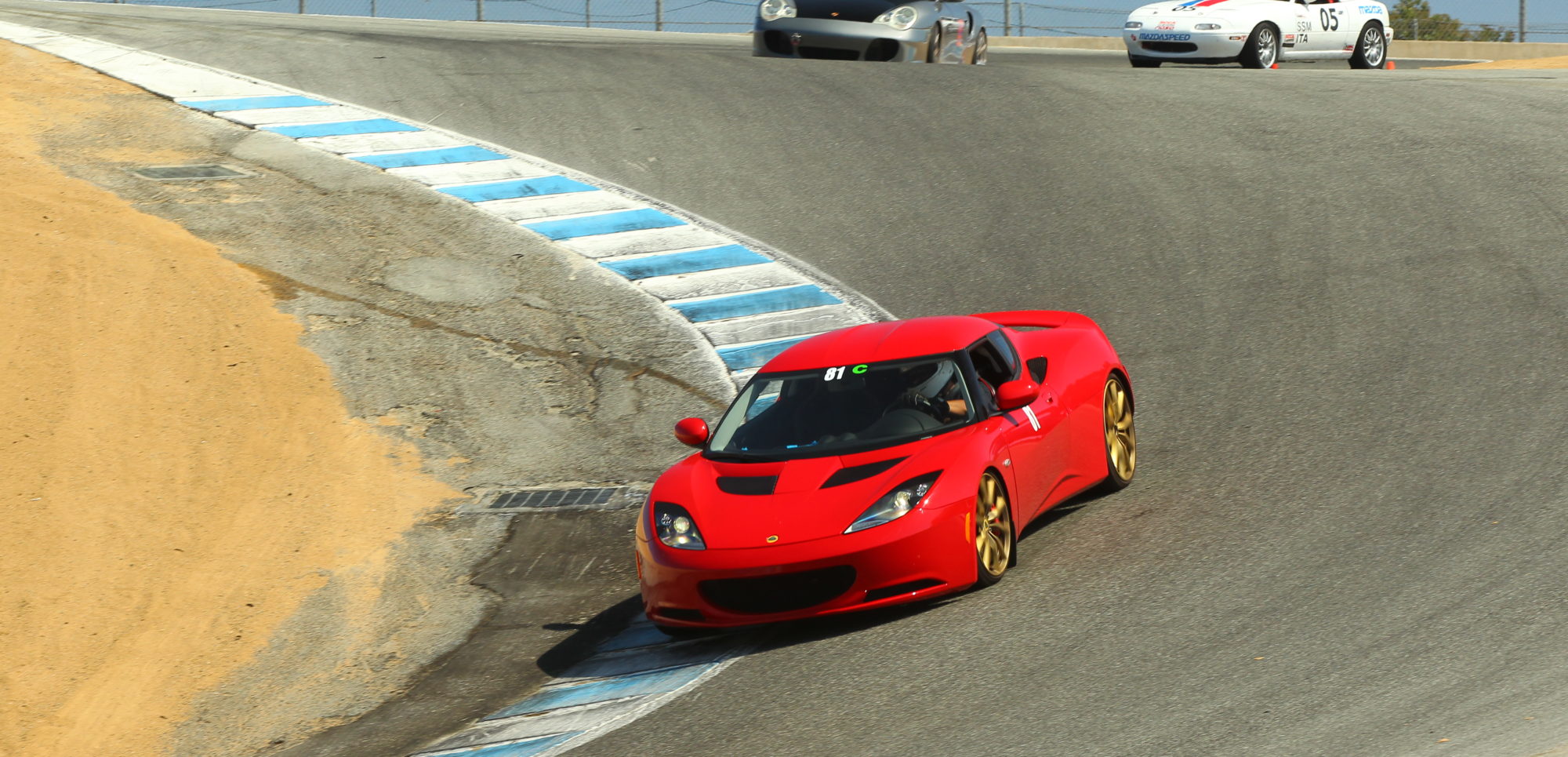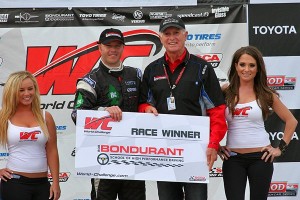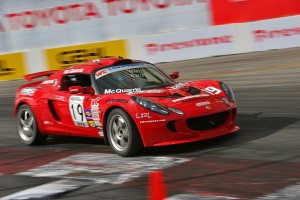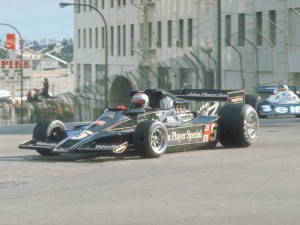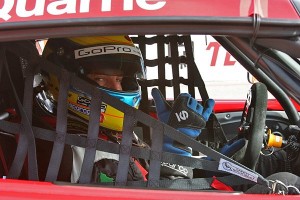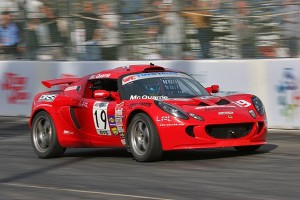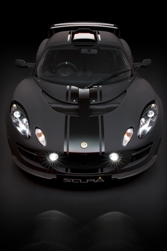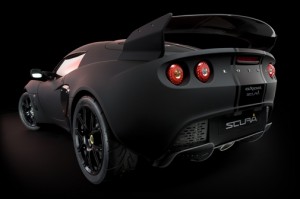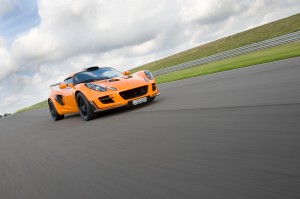Chris Harris celebrates the cult of the road racer by gathering together the very best of the breed. Renault R26.R, 430 Scuderia, GT3 RS, Exige Cup 260 and more battle it out against Colin McRaes’ 1997 Subaru WRX World Rally Championship car. The Exige clip is at the start of the second video.
LPL Motorsports and Tyler McQuarrie rejoin World Challenge in Mosport
On the heels of their first appearance – and first win – at the World Challenge Long Beach Grand Prix, Tyler McQuarrie will return to the seat of the No.19 LPL / Lotus Exige S at the Grand Prix of Mosport to contest rounds four and five of the 2010 World Challenge season.
McQuarrie had a sensational debut for himself, as well as the LPL Motorsports team and the Lotus Exige S with a dominating performance at last month’s Long Beach Grand Prix. McQuarrie, who is best known as a star in the Formula Drift Pro Championship where he drives a V8 powered Nissan 350z for the Falken Tire team, is excited to have another go in World Challenge.
“Long Beach was really a dream weekend,” said McQuarrie, a Pleasant Hill, Calif. resident. “We definitely had some challenges that we had to overcome, but the race was phenomenal and all credit should go to the LPL / DRS crew that didn’t sleep for weeks before the event to get the car ready.”
With the win, McQuarrie and the team got a big trophy, a reduction in boost, and weight added to their Lotus Exige S. In between his Formula Drift schedule, McQuarrie has been at the track with the LPL Motorsports team, getting the No. 19 Lotus Exige S dialed in to its new configuration. After a few days spent at Buttonwillow Raceway Park, McQuarrie is confident that the car and team are ready for the challenges of Mosport – a track that he is learning thanks to a computer simulator.
“The track seems like it will suit the Lotus very well, although we may have a disadvantage on the Andretti straightaway due to the changes to the car after Long Beach,” said McQuarrie. “We also know that we are racing against guys who have lots of data, lots of laps, and have won at Mosport. We are just going to give it the same effort that we did in Long Beach, and rely on the great handling of the Lotus Exige S to get us another win.”
The weekend kicks off with practice, qualifying, and round four on Saturday, with another qualifying session and round five on Sunday. Fans will be able to keep up with the McQuarrie and the LPL Motorsports team by following McQuarrie on Twitter, at twitter.com/tylermcquarrie (@tylermcquarrie).
LPL Motorsports is currently planning to continue with the World Challenge season and welcomes inquiries from drivers interested in partnering McQuarrie in a second Exige S.
[press release from LPL Motorsports]
Lotus wins the Long Beach SCCA World Challenge Event
Tyler McQuarrie, of Walnut Creek, Calif., won the GTS class race of the Toyo Tires World Challenge at Long Beach. Making his World Challenge debut, McQuarrie took the GTS pole before cruising to a 49.535-second flag-to-flag victory in his No. 19 LPL/DRS/Switcars/LCS/Dayco/M&T Lotus Exige S.
The GTS win was the first time a Lotus had won a race of any kind at Long Beach since Mario Andretti won the 1977 Formula One event in a John Player Lotus.
“I had a great start and actually got by a couple of GT cars,” McQuarrie said. “I didn’t have a working radio in the race, so I didn’t actually realize who was behind me. I looked up at the screen on the second lap and saw one of the Acuras head to the pits with the hood up. I dialed it back just a little bit when I felt I could.”
“I have to really thank the LPL and DRS team. They only got this car about five weeks ago and really did a fantastic job with it. To be able to run it here at Long Beach—to run both weekends, is really awesome. I think April in Long Beach is a little bit like May in Indy. It’s a special time and to win here is just awesome.”
The race from Long Beach will be broadcast May 1 at 4:30 p.m. (EDT) on Versus.
The World Challenge Championships return to action with a doubleheader at Mosport International Raceway, May 21-23.
[via SCCA World Challenge]
Lotus Exige Scura to be unveiled at Tokyo
Lotus Cars unveils its latest special edition – the Exige Scura, so called due to its dramatic matt black and carbon fibre theme, at the Tokyo International Motorshow on 21st of October 2009.
Translated as ‘dark’ from Italian, the name ‘Scura’ reflects the stealth character of this already fierce looking Lotus and its stunning soft-feel matt black paint finish. Limited to just 35 cars globally, this Exige evokes a desire to ‘indulge your dark side’. This is a serious looking car and enhancements to performance and a reduction in weight from the production level Exige S means that the Exige Scura demands to be driven by a serious driver.
Contrasting high gloss ‘Phantom Black’ triple stripes run the length of the car and a carbon fibre front splitter, oil cooler inlet vanes, side airscoops and rear spoiler enhance the stunning distinction between the different textures and exaggerate the tactile quality of the velvety touch to the matt black paint finish.
Luke Bennett, Director of Lotus Cars said, “The Exige Scura is a stunning vehicle which offers an adrenaline fuelled experience and is a real head-turner! Our Exige customers choose Lotus because we deliver thrilling performance and dynamic design and this special edition fits the bill on both counts.”
Continuing the dark ‘Scura’ appearance into the interior, carbon fibre is used extensively to compliment the exterior theme and reduce weight. The seats and centre console are crafted from carbon fibre and the handbrake and gear knob have a special anodized treatment which leaves the metal with an anthracite colour finish. All carbon fibre components have been beautifully finished in high-gloss clear lacquer allowing the weave to remain exposed which gives the cabin a raw and racy ambiance.
Whilst there is no doubt that this is a visually stunning car, the Exige Scura is not just about its looks – it begs to be taken on track, and its racing character encompasses poise, power and technology to make it a serious contender. Equipped with the most powerful engine in the Exige range and generating 260PS, the Exige Scura achieves a top speed of around 245 km/h and reaches 0-100 kmh in just 4.1 seconds.
Other equipment fitted as standard to boost the Exige Scura’s track credentials include:
* Launch control to ensure optimum performance from a standing start
* Variable slip traction control, enabling the driver to tune the car to track surface conditions and their own driving style
* Ohlins 2-way adjustable dampers for personalised ride and handling characteristics
Roger Becker, Vehicle Engineering Director, highlighted the performance of the Exige Scura, “There are very few cars in the world that turn in the performance of the Exige Scura without the penalty of very high fuel consumption and emissions. As with all Lotus sportscars we offer the best of both worlds – a zero to 100 km/h time of just over 4 seconds and a CO2 figure of 199 g/km; all this is down to light weight and a strict adherence to Lotus’ core brand values.”
Considering the performance on offer, the Exige Scura boasts impressive all round fuel economy with an Official European Combined Cycle figure of 8.5 litres/100 km and 6.5 litres/100 km on the Official European Extra Urban Cycle and emissions of 199 g/km of CO2.
Orders for the ‘Lotus Exige Scura’ will be accepted from 21 October 2009 in Europe, South Korea, Australia, South Africa, Thailand, Taiwan, Hong Kong, Singapore, New Zealand, Indonesia and Malaysia. This special edition will be available on the same basis in Japan known as the ‘Lotus Exige Stealth’.
The Exige Scura in more detail
Performance and enhancements;
* 0-100 kmh in 4.1 seconds and 199 g/km CO2
* Lotus Launch Control and Lotus Traction Control as standard
The Lotus Exige Scura uses the 1.8 litre supercharged and intercooled 260 PS engine from the range topping Exige Cup 260, including the lightweight flywheel and lightweight supercharger pipework. Coupled with Ohlins 2 way adjustable dampers and Eibach Springs with variable height spring platforms, unique matt black lightweight forged wheels and super sticky Yokohama A048 LTS tyres, ride and handling is as expected for a Lotus!
Lightweight carbon fibre components, including sports seats, interior centre console, front splitter, oil cooler inlet vanes, side airscoops and rear spoiler help to keep the weight to 10kg less than the Lotus Exige S (at just 925 kg).
Lotus Launch Control and Lotus Traction Control – additions recommended for track driving
Lotus Launch Control and Lotus Traction Control were originally developed for the Lotus Exige GT3 racing programme.
The launch control allows the driver to determine the number of revs they wish to use during a standing start. Having programmed that limit, the driver then holds the throttle pedal down fully and sidesteps the clutch pedal for a very quick departure from the line. The clutch damper cushions the severity of the clutch to transmission engagement to minimise the stresses to the drivetrain. The launch control allows wheel-spin until 10 km/h (6 mph) to further reduce drivetrain stress, after which the traction control assumes its duties at the defined level set by the driver.
As with launch control, the amount of traction control required can be dialled in from the driver’s seat and altered on the move to suit the characteristics of particular corners. The amount of traction control can be varied in over 30 increments from an optimum 7 percent tyre slip to completely inactive. The message display in the new instrument pack displays what degree of traction control is being currently utilised.
Suspension
To suit individual driving styles and road conditions, drivers will now be able to tune the Exige suspension with the Ohlins two-way adjustable dampers (which have 60 compression and 22 rebound settings) and ride height adjustment to reduce the ride height from 130 mm to 120 mm.
Performance, Economy and Emissions
The Lotus Exige Scura is capable of incredible track performance which and at the heart of its success is the aerodynamic package, which produces 42 kg of downforce at 160 km/h (100 mph) increasing grip and stability at higher speeds. This downforce, coupled with a top speed of around 245 km/h (152 mph) and a zero to 160 km/h (100 mph) in circa 9.9 seconds, 0 to 100 km/h in circa 4.1 seconds (0 to 60 mph in around 4 seconds), means that the Exige Stealth is not only stunning to look at but a phenomenal performer too. Combined cycle fuel consumption is 8.5 l/100km and the CO2 emissions 199 g/km.
Engine
The supercharged and intercooled engine in the Exige Scura has a maximum power output of 260 PS (257 hp) at 8000 rpm and a torque figure of 236 Nm (174 lbft) at 6000 rpm. This significant amount of extra power and torque over the production level Exige S together with the VVTL-i variable cam system ensures that there is a smooth and linear delivery of power from low engine speeds all the way to the maximum 8000 rpm (8500 rpm transient for 2 seconds). The supercharger (with a sealed-for-life internal mechanism meaning that it does not require the use of the engine’s oil) is run from the crankshaft and has an integral bypass valve for part load operation. Charge air (air under pressure from the supercharger) is cooled through an air-to-air intercooler (the air enters via the enhanced roof scoop) before being fed into the engine itself. All charge air ducting has been kept as short as possible with large diameter pipes to minimise restriction and maximise throttle response and efficiency. Four high capacity injectors and an uprated fuel pump add additional fuel under hard acceleration or continuous high speed driving – only on the track, of course!
A lightweight flywheel is fitted (giving even greater flexibility and response to the gear change), a sports-type clutch plate and heavy duty clutch cover transfer the engine power and torque to the lightweight C64 six-speed gearbox (with an aluminium casing) – with the same perfectly spaced ratios as the Exige S. An Accusump (engine oil accumulator unit) is included in the whole package as an oil reservoir back-up for extreme track use ensuring that, under those conditions, the engine oil pressure remains constant.
Recommended retail prices of the standard road specification Lotus Exige Scura
UK (MSRP)
Recommended retail price (including VAT) is £45,000 (an additional £950 is charged for on the road costs. These include delivery, PDI, first service, number plates, first registration fee, valet, 12 months Road Fund Licence and a full tank of fuel).
Recommended retail prices of the standard road specification Lotus Exige Scura for the following markets (MSRP) (including transport, delivery, local taxes and first service but excluding registration, license plates and or a full tank of fuel):
Belgium € 61.820,–
France € 61.200,–
Italy € 61.885,–
Switzerland CHF 90.225,–
Recommended retail prices of the standard road specification Lotus Exige Scura for the following markets (MSRP) (including local taxes but excluding transport, registration, license plates and or a full tank of fuel):
Germany € 60.000,–
Recommended retail prices for other Euro Zone Countries (MSRP) (excluding local taxes, transport, registration, license plates and or a full tank of fuel):
Euro Zone € 50.420,–
Paint Warranty
The Lotus Exige Scura is painted in a ‘soft feel’ water borne matt black paint finish that is resistant to most normal forms of atmospheric attack provided the special cleaning and maintenance requirements as specified by Lotus are strictly adhered to. However due to the textured matt finish, fading or discolouration of all or part of the matt paint finish may occur during the early life of the vehicle and this is considered normal and is specifically excluded from any warranty given by Lotus. The special matt paint finish utilised on the Lotus Scura is provided with a limited warranty of the earlier of 12 months or 12,000 miles/20,000 km from the date of first registration of the vehicle. Please consult your Authorised Lotus Dealer for full details.
Lotus Exige Scura
Lotus Exige Scura Lotus Exige Scura Lotus Exige Scura
Official European Combined Cycle = 8.5 litres / 100 km (33.2 mpg)
Official European Extra Urban Cycle = 6.5 litres/100 km (43.5 mpg)
Official European Urban Cycle = 11.9 litre/100 km (23.7 mpg)
CO2 emissions = 199 g/km
2010 Lotus Exige Cup 260 specification released
The track focussed homologated-for-the-road 2010 Model Year Lotus Exige Cup 260 takes design clues and technical innovations from the Lotus Exige GT3 racecar and combines with class leading emissions of just 199 g/km CO2 and exhilarating performance of 0-100 km/h in just 4.1 seconds.
· Extensive use of carbon fibre
· Motorsport lightweight wheels
· Ohlins 2-way adjustable dampers
· Rear chassis stiffness increased by 30%
The Lotus Exige Cup has developed a cult following and a dedicated fan base since the first Lotus Exige Cup 240 was unveiled in 2006. Over the last 4 model years several hundred Exige Cup Cars have been sold, either specifically for race and track use or for a pure road going driving experience. The latest Exige Cup 260, with 260 PS, takes the 38 kg weight savings introduced in the last years model, combines them with the extensive body and aerodynamic improvements and revisions introduced on the 2010 Exige in March 2009 and tops them off with new components and technologies to produce the most focused and pure Exige yet.
Roger Becker, Director of Vehicle Engineering for Lotus said, “The Lotus Exige Cup 260 is the epitome of the Lotus brand philosophy of performance through lightweight. Colin Chapman, founder of Lotus, once said “Adding power makes you faster on the straights; subtracting weight makes you faster everywhere” and the Exige Cup 260 totally proves this, being one of the most exhilarating, focussed and pure sportscars on the road today.”
The 2010 Model Year Exige Cup 260 is fully homologated for road use in Europe and key markets in Asia and North America – a must have for many race competition programmes where a road legal car has to be entered. The Lotus Exige Cup 260 is also eligible to compete in the Lotus Cup Europe race series, organized and run by LoTRDC.
The 2010 Model Year Exige Cup 260 takes the design and aerodynamic changes first introduced on the Exige S earlier this year to enhance the look and improve aerodynamic performance.
The lightweight, unpainted carbon chord composite rear wing is based on the design from the Exige GT3 road car concept shown at the Geneva Motorshow in 2007. Compared to the 2009 Model Year Exige Cup 260 tailgate-mounted wing, it is 181 mm wider and mounted 46 mm higher and 61 mm further back. It is attached to the rear bodyshell clam via rear end plates which not only increases the stiffness of the whole structure but also ensures that as much of the airflow as possible passes over the rear wing. This careful airflow management increases stability, reduces drag and, most importantly, maintains the impressive downforce figures of 42 kg at 160 km/h.
The restyled front end includes a larger, more angular air intake to help funnel more air through the radiator, to improve the efficiency of the engine. Ahead of the front wheels on either side of the main aperture, two larger air intakes increase the airflow to the twin oil coolers. Horizontal vanes, made from lightweight carbon fibre bisect these oil cooler air-intakes to stabilise the airflow to further increase the cooling efficiency.
Mounted below the three air intakes is a new aerodynamic splitter for the 2010 Model Year Exige. Made from lightweight carbon chord composite, the splitter is extended to wrap around the whole of the front end and chiseled side lips are raised to deflect air around the tyres to reduce drag.
Rear chassis stiffness increases by 30%
The Exige Cup 260 now has an evolution of the rear diffuser and structural shear panel based on the version developed for the Exige GT3 race car, which increases the lateral stiffness of the rear subframe by 30% further enhancing its outstanding handling.
The rear diffuser and structural shear panel links the subframe to the main chassis to give greatly increased lateral stiffness to the rear subframe suspension pickup points, resulting in better tyre contact patch control.
This stiffness is also more applicable to those drivers who race or take part in track days using slick tyres that can also be fitted to the Exige Cup 260.
Ohlins two-way adjustable dampers are now fitted as standard, adding even more personalisation of the driving characteristics so the driver can tune the Exige Cup 260 to their driving style and road or track conditions.
A restyled front end and new larger, rear wing that not only reduces drag, but also gives a more muscular stance enhancing the lightweight shrink-wrapped look of the whole car.
Like the 2010 Model Year Lotus Exige S, the 2010 Model Year Exige Cup 260 exploits the Lotus philosophy of using weight reduction to increase performance and reduce emissions. Fuel economy is impressive with an Official European Combined Cycle figure of 8.5 litres / 100 km (reduced from 9.1 litres / 100 km (combined) for the 2009 Model Year Exige Cup 260), a frugal 6.5 litres/100 km on the Official European Extra Urban Cycle and just 199 g/km of CO2 (reduced from 216 g/km of CO2 for the 2009 Model Year Exige Cup 260). Continuous engineering improvements over the last year including careful whole vehicle optimisation has enabled this sportscar to be even better for fuel economy and emissions.
Luke Bennett, Operations Director for Lotus Cars said, “The best thing about the Lotus Exige Cup 260 is its performance, on the track it’s sensationally quick in a straight line and attacks corners with razor-sharp precision. With the lightness and agility you’d expect from a Lotus and the almost telepathic feedback to the driver, this car produces an outrageously fun drive.”
The Exige Cup 260 follows this lightweight philosophy closely. Taking the already lightweight Lotus Exige S, the weight saving programme has looked at all areas of the car where components can be replaced with a lighter version (without pushing the costs beyond the reach of the serious track day driver or clubman racer) or where components can be removed completely without detracting from the purity of the driving experience:
Carbon fibre (resulting in a weight saving of 12kg):-
· Roof Panel
· FIA and HANS compliant driver and passenger seats*
· One piece carbon fibre dash top panel
· Rear tailgate
· Centre tunnel
· Front access panels
· Front splitter (carbon chord)
· Side air intake ducts
· Rear spoiler (carbon chord)
(* The seats are FIA compliant when fitted in conjunction with fixed seat runners that are available as a track only dealer fit option).
Lightweight components (resulting in a further weight saving of 22kg):-
· Lightweight ‘motorsport’ battery
· Ultra-light five spoke forged alloy wheels
· Revised rear engine subframe with lightweight coating
· Lightweight fly wheel
· Lightweight composite bulkhead panel replaces rear window
· Alloy supercharger U-bend pipes
Removing some other non essential components and equipment such as the interior and boot carpets, front mudflaps, battery cover, interior mirror, sunvisors, rear tailgate gas strut, results in a further weight saving of 4kg.
However, as optional extras should a customer wish, air conditioning and an interior noise reduction pack are available, together with the complete range of Lotus metallic, lifestyle and premium paint colours
The MY2010 Exige Cup 260 weighs in at just 890 kg, giving an impressive power to weight ratio of 288 hp / tonne (291 PS / tonne). But, of course, power to weight alone does not make a highly competitive race or track car, so in addition, the Exige Cup 260 has a formidable list of standard performance focused equipment, as follows:-
Lotus Launch Control and Lotus Traction Control – additions recommended for track driving
Lotus Launch Control and Lotus Traction Control was originally developed for the Lotus Exige GT3 racing programme
The launch control allows the driver to determine the number of revs they wish to use during a standing start. Having programmed that limit, the driver then holds their foot down fully on the throttle pedal and sidesteps the clutch pedal for a very quick departure from the line. The clutch damper cushions the severity of the clutch to transmission engagement to minimise the stresses to the drivetrain. The launch control also keeps wheel-spin at bay until 10 km/h (6 mph), after which the traction control assumes its duties.
As with launch control, the amount of traction control required can be dialled in from the driver’s seat and altered on the move to suit the characteristics of particular corners. The amount of traction control can be varied in over 30 increments from an optimum 7 percent tyre slip to completely inactive. The message display in the new instrument pack displays what degree of traction control is being currently utilised.
Wheels and Tyres
All new Lotus Sport lightweight forged alloy wheels, thought to be the lightest original equipment wheels in the world, weigh just 5.65 kg (front) and 7.75 kg (rear). These ultra lightweight wheels reduce the unsprung mass therefore further improving the handling and contribute a weight saving of approximately 800 g over the already super light forged 2009 Model Year Exige Cup 260 wheels. The wheels are shod with Lotus specific LTS construction and compound Yokohama A048 tyres† to maximise grip and achieve the ride and handling targets set by Lotus engineers.
† For GCC States Yokohama A048 LTS tyres are replaced with Toyo Proxes R888 tyres.
Safety Equipment
Lotus Exige Cup 260 cars have the safety equipment expected of a race car, with FIA and HANS compliant carbon fibre lightweight sports seats*, normal 3-point “Webb Lock” harnesses (four or six point driver and passenger seat belt harnesses are available for track use only).
(* The seats are FIA compliant when fitted in conjunction with fixed seat runners that are available as a track only dealer fit option).
A high tensile steel roll over hoop is now fitted with a body coloured Lotus Sport A-Frame as standard and the chassis is already pre-drilled to fit a full front roll cage – a simple dealer fit process involving just the removal of the roof panel for access prior to fitting. Completing the additional safety equipment is a FIA compliant electronic ignition kill switch, with cockpit and external activation, and a FIA compliant plumbed electrically activated fire extinguisher system, again with cockpit and external switches.
Like all current Lotus cars, the Exige Cup 260 is built around a very strong extruded and bonded aluminium chassis tub. Attached to the chassis is a sacrificial energy absorbing composite front structure designed to help absorb crash energy in the event of impact.
Suspension
To suit individual driving styles and road conditions, drivers will now be able to tune the Exige suspension with the Ohlins two-way adjustable dampers (which have 60 compression and 22 rebound settings) and ride height adjustment to reduce the ride height from 130 mm to 120 mm. An adjustable front anti-roll bar allows customers to tailor the handling characteristics of the car to their own requirements.
As the Exige Cup 260 cars are equipped for track use, a double shear track control arm brace is provided to cope with the expected kerb abuse during track racing or hard track day driving.
Brakes
The brake system includes large diameter 308 mm 2-piece cross-drilled and ventilated front discs and 282 mm cross-drilled and ventilated discs at the rear, upgraded Pagid RS14 sports brake pads set into the brake calipers (AP Racing two piece radially mounted, 4 piston at the front and Brembo sliding at the rear), and stainless steel braided brake hoses – all linked to the proven Lotus track-tuned servo-assisted four-channel ABS system that enhances braking performance and minimizes stopping distance without taking over from the skill of the driver.
Performance, Economy and Emissions
The Exige Cup 260 is one of the quickest road cars around a circuit. Key to this incredible track performance is the aerodynamic package, which produces 42 kg of downforce at 160 km/h (100 mph) increasing grip and stability at higher speeds. With a top speed of circa 245 km/h (152 mph) and a zero to 160 km/h (100 mph) in circa 9.9 seconds, 0 to 100 km/h in circa 4.1 seconds (0 to 60 mph in circa 4 seconds), the MY2010 Exige Cup 260 is the perfect partner for the serious racer. Combined Fuel Consumption is 8.5 l/100km and the CO2 emissions 199 g/km.
Engine
The supercharged and intercooled engine in the Exige Cup 260 has a maximum power output of 260 PS (257 hp) at 8000 rpm and a torque figure of 236 Nm (174 lbft) at 6000 rpm. This significant amount of extra power and torque now available together with the VVTL-i variable cam system ensures that there is a smooth and linear delivery of power from low engine speeds all the way to the maximum 8000 rpm (8500 rpm transient for 2 seconds). The Roots-type Eaton M62 supercharger (with a sealed-for-life internal mechanism meaning that it does not require the use of the engine’s oil) is run from the crankshaft and has an integral bypass valve for part load operation. Charge air (air under pressure from the supercharger) is cooled through an air-to-air intercooler (the air enters via the enhanced roof scoop) before being fed into the engine itself. All charge air ducting has been kept as short as possible with large diameter pipes to minimise restriction and maximise throttle response and efficiency. Four high capacity injectors and an uprated fuel pump add additional fuel under hard acceleration or continuous high speed driving – only on the track of course!
A lightweight flywheel is fitted (giving even greater flexibility and response to the gear change), a sports-type clutch plate and heavy duty clutch cover transfer the engine power and torque to the lightweight C64 six-speed gearbox (with an aluminium casing) – with the same perfectly spaced ratios as the Exige S. A torque-sensing limited slip differential is fitted as standard, with a plate type limited slip differential available as an option. An Accusump (engine oil accumulator unit) is included in the whole package as an oil reservoir back-up for extreme track use ensuring that, under those conditions, the engine oil pressure remains constant.
Electrical supply is provided by a lightweight motorsport battery which saves a massive 5 kg of weight sitting behind the rear axle – again weight saving is not just the removal of mass but ensuring that this mass is removed where it most affects performance and handling.
Power and torque curves
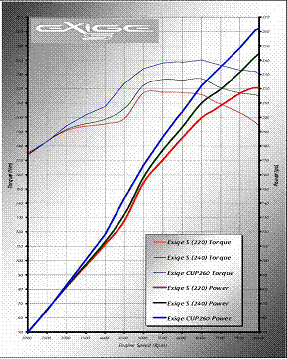
Roof Scoop
The Lotus Sport Exige Cup 260 has a high flow, full-length carbon roof scoop as part of the lightweight carbon roof panel, which not only saves 4 kg but also ensures efficient cooling through the intercooler, which in turn allows the Exige Cup 260 to gain a higher charge density in the cylinders improving efficiency further.
Specification
The standard specification Lotus Exige Cup 260 is road legal within the European Union, and can be registered for road use.
The Exige Cup 260 is available now for sale in Europe. Individual recommended retail prices for some major European markets are listed below:
Recommended retail prices of the standard road specification Lotus Exige Cup 260
UK (MSRP)
Recommended retail price (including VAT) is £45,000, (an additional £950 is charged for on the road costs. These include delivery, PDI, first service, number plates, first registration fee, valet, 12 months Road Fund Licence and a full tank of fuel.
Recommended retail prices of the standard road specification Lotus Exige Cup 260 for the following markets (MSRP) (including transport, delivery, local taxes and first service but excluding registration, license plates and or a full tank of fuel):
Belgium € 64.825
France € 64.200,–
Italy € 64.900,–
Switzerland CHF 94.700,–
Recommended retail prices for the following markets (MSRP) (including local taxes (excluding transport, registration, license plates and or a full tank of fuel):
Germany € 62.950,–
Recommended retail prices for Euro Zone Countries (MSRP) (excluding local taxes, transport, registration, license plates and or a full tank of fuel):
Euro Zone € 52.899,–
Warranty
The Lotus Exige Cup 260 will have a limited manufacturer’s warranty. The manufacturer’s warranty will be void if the car has ever been used on road or on track with “slick” or equivalent racing tyres. If the launch control facility is utilized, the warranty on related powertrain components is void. Clutch assembly and brake discs are excluded from the manufacturer’s warranty. The manufacturer’s warranty will not apply to any car which is subjected to race or competition use including but not limited to timed runs or laps. Purchaser’s Statutory rights are not affected.
Lotus Exige 260 Cup Vs Lotus 25
Drivers Republic takes the Lotus Exige 260 Cup to Goodwood to see if it can beat Jim Clarks lap record in a Lotus 25. Click through to see the result.

2010 Lotus Exige S introduced
The 79th International Geneva Motor Show sees the introduction of the exciting new 2010 Model Year Lotus Exige S with a newly designed front end, a new rear wing and impressive emissions of just 199 g/km CO2.
The Lotus Exige is a renowned high performance coupe that has a well earned reputation of choice for drivers who demand uncompromised performance, both on the road and on the track.
Lotus has always pursued efficiency and fuel economy and for the 2010 Model Year Lotus Exige S, Lotus has reduced the emissions to only 199 g/km CO2 and increased the fuel economy to an impressive 8.5 litres/100 km on the Official European Combined Cycle and a frugal 6.5 litres/100 km on the Official European Extra Urban Cycle.
The 2010 Model Year also sees the introduction of a few key changes to the Exige to enhance the look and improve aerodynamic performance.
A restyled front end and new larger, rear wing that not only reduces drag, but also gives a more muscular stance enhancing the lightweight shrink-wrapped look of the whole car.
The composite rear wing is based on the design from the Exige GT3 road car concept shown at the Geneva Motorshow in 2007. Compared to the 2009 Model Year Exige tailgate mounted wing it is 181 mm wider and mounted 46 mm higher and 61 mm further back. It is attached to the rear bodyshell clam via rear end plates which not only increases the stiffness of the whole structure but also ensures that as much of the airflow as possible passes over the rear wing. This careful airflow management increases stability, reduces drag and, most importantly, maintains the impressive downforce figures of 42 kg at 160 km/h.
The restyled front end includes a larger, more angular air intake mouth to help funnel more air through the radiator, to improve the efficiency of the engine system. Ahead of the front wheels on either side of the main aperture, two larger air intakes increase the airflow to the twin oil coolers. Horizontal vanes bisect these oil cooler air-intakes to stabilise the airflow to further increase the cooling efficiency.
Since the Exige S2 was launched in 2004, the power has increased from 190 hp through 220 hp to 240 hp in standard road form – more for the track centric Exige Cup 260 – and the new larger air intakes improve engine cooling for these current higher powered Exige variants.
Mounted below the three new air intakes is a new aerodynamic splitter for the 2010 Model Year Exige. Made from a lightweight composite, the splitter is now extended to wrap around the whole of the front end and chiseled side lips are raised to deflect air around the tyres to reduce drag.
Mike Kimberley, Chief Executive of Group Lotus plc said, “Over the years, the Lotus Exige has developed a hardcore fan base around the world and its popularity has placed it as one of the legendary sportscars of the 21st century. So far, over 5000 Exiges have been hand-built at our high-tech manufacturing facility making it a significant contributor to our global production. The lightweight Exige has one of the highest specific power outputs of any globally emissions certified car and 133 hp per litre is a perfect demonstration of Colin Chapman’s philosophy of performance through light weight and of Lotus’ relentless pursuit of efficiency. The same technology that makes a lightweight car a high performer also makes it efficient – how many cars have performance figures of 0 – 100 km/h in 4.77 secs but produce only 199 g/km CO2?”
Like all Lotus cars, the functional components of the car are also beautifully designed as Russell Carr, Chief of Lotus Design, explains, “For 2010 we have taken the already visually extreme Exige and given it even more visual drama. The changes we have integrated into the front and rear of the Exige signal an even clearer and purposeful intent. The purposeful rear wing is race inspired, the new angular air intakes and full width splitter gives a more hard-edged and aggressive look. Overall, the Exige appears more planted and gives the illusion that both the front and rear of the car are wider than they really are without losing its agile and lithe character.”
Roger Becker, Director of Vehicle Engineering said, “The changes we have made to the Exige for 2010 Model Year are quite subtle when taken individually, but taken as a complete package they make significant improvements to aerodynamics and the overall look of the car. The Exige is a classic fit-for-purpose performance machine, the design tweaks we have made have reduced the drag, cleaned up the airflow around the front and rear of the car, whilst retaining the impressive balanced downforce figures, to give an exciting high performance drive.”
The specification of the highly successful 2009 Model Year Exige Cup 260, unveiled at the Paris Motorshow in 2008 remains unchanged.
The 2010 Exige in more detail:
Driver and passenger airbags are standard on all models while an on-board Tyre Pressure Monitoring System is standard in the USA.
The instrument pack in the Exige contains much more than just a pair of stylishly back-lit dials. It also features a high-definition LCD message panel that can display a scrolling text message with vehicle systems information.
The instrument pack always displays the fuel gauge, engine temperature and odometer, however you can select to display the time, trip distance or a digital read-out of your speed in the opposite calibration to that of your speedometer dial – if your dial is in mph, the readout is in km/h.
Warning symbols are ‘secret until lit’, keeping the instrumentation free from visual clutter and distraction until necessary. Gearchange ‘shift’ lights similarly remain hidden until required. There are three shift up warning lights, cumulatively lighting when the driver is getting closer to the rev limiter and when all three are illuminated, they flash to indicate that you should have changed up a gear by now!
A “key” issue
The Exige has a “Thatcham approved” alarm/immobiliser system and the ignition key incorporates the controls for the alarm/immobiliser and central locking functions. This key features three buttons, the one which locks the doors and sets the alarm/immobiliser is stylishly crowned with the famous Lotus roundel. The second button unlocks the doors and de-actives the alarm/immobiliser, and the final button is a panic alarm button.
The contents of the Touring pack, for the Exige S includes:
• Full leather or Microfibre suede-effect interior
• Leather trimmed centre console
• Leather handbrake gaiter
• Sound system iPod* connection
• Full carpets, with embroidered logo
• Auxiliary driving lights (in markets where legally allowed)
• Sound insulation kit
• Cup holder
The Exige S Sport pack includes:
• Bilstein sports dampers
• Traction control
• Adjustable front anti-roll bar
• T45 roll bar, with integrated harness mounts
The Exige S Performance Pack – more punch, more ability for Exige S
• 308 mm front cross-drilled and vented discs with AP Racing four piston callipers
• Uprated front and rear brake pads
• Full length upsized roof scoop
• Variable slip traction control
• Uprated clutch plate and cover
• Uprated vehicle performance through enhanced power and torque delivery
• Launch control
With the Exige performance pack, the power is raised to 240 PS / 179 kW (minimum) at 8000 rpm courtesy of a Magnuson/Eaton M62 supercharger, new faster flowing injectors and higher torque clutch system and an upsized roof scoop to feed more air to the supercharger intercooler system.
This hike in power, together with an increase in torque to 170 lbft / 230 Nm / 23.5 kgm at 5,500 rpm from the standard 158.6 lbft / 215 Nm / 22 kgm at 5500 rpm, helps whisk the Performance Pack Exige S from zero to 60mph in 4.5 secs and 0-100km/h in 4.77 secs, and on to 100mph in 11.97 secs. Top speed rises to 145 mph. The power and torque of the 240 PS engine is increased across the rev range giving even more flexibility. Despite these high levels of performance the fuel economy is impressive with a new combined figure of 8.5 litres / 100 km and 199 g/km CO2 – reduced from 9.1 litres / 100 km (combined) and 216 g/km CO2 for the 2009 Model Year Exige. Continuous engineering improvements over the last year including careful whole vehicle optimisation has enabled this sportscar to be even better for fuel economy and emissions.
Of course the increased power and straight-line performance are only a couple of elements of the Performance Pack option. The clutch is uprated and a clutch damper fitted; there are thicker, 308mm diameter cross-drilled and vented discs at the front clamped by AP Racing four-piston callipers; the standard brake pads are replaced by uprated pads.
Keen to pass on lessons learned on the track with the Exige GT3 racing programme, Lotus Sport has contributed another important track specific technology to the Performance Pack – launch control combined with variable traction control.
From the driver’s seat the track orientated launch control allows you to determine the engine revs you wish to use during a standing start on the track. Having programmed that limit, it will not be exceeded when you then hold down the throttle and sidestep the clutch at departure from the line. The clutch damper cushions the severity of the clutch / transmission engagement to minimise the stresses to the drivetrain (noting that continuous abusive standing start applications will destroy the drivetrain components). The launch control also keeps wheelspin at bay until 6 mph, after which the traction control assumes its duties.
As with launch control, you can dial in the amount of traction control you require from the driver’s seats, altering it on the move to suit driving style and the characteristics of particular corners. The amount of traction control can be varied in over 30 increments from an optimum 7 percent tyre slip to completely off. The message display in the new instrument pack displays what degree of traction control you have currently dialled in.
The beauty of all the packs is that they can be combined so a customer can have the additional interior and exterior equipment from the Touring pack with the sport focussed equipment from the Sport pack.
Air conditioning, Lotus traction control and limited slip differential are available as stand-alone options.
Customers wanting to add further finishing touches to their Exige – such as specifying adjustable dampers and forged wheels can do so by ordering from an extensive range of accessories.
Colours
The Premium Colour Range has been designed to further enhance the choice for customers to individualise their cars. Most of the paints in this range require a more sophisticated application process and are from our paint supplier’s premium range. The paint colours in this range have been individually priced, and it is Lotus’ intention to extend and change this range at periodic intervals.
The 2010 Model Year Exige S will enter the EU markets in May 2009.
Exige S: 199 g/km CO2
8.5 litres/100 km (33.2 mpg) Combined Cycle
11.9 litres/100 km (23.7 mpg) Urban Cycle
6.5 litres/100 km (43.5 mpg) Extra Urban Cycle
* iPod is a trademark of Apple inc registered in the USA and other countries
